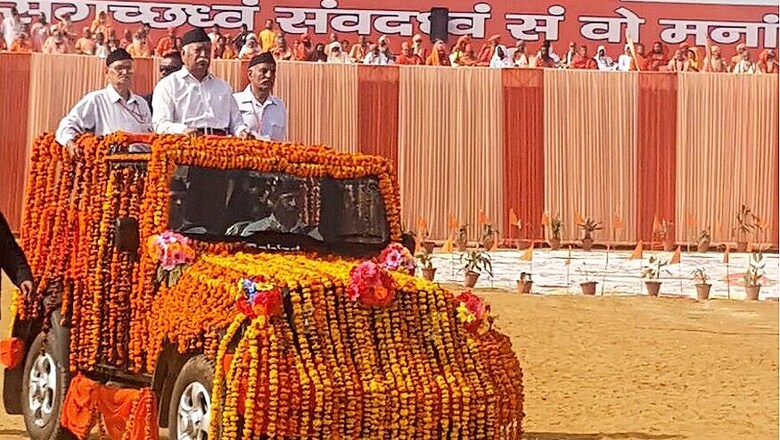
views
New Delhi: A delegation of the Communist Party of China (CPC) on an official visit to Delhi two years ago expressed interest in meeting some senior leaders of the Rashtriya Swayansewak Sangh (RSS). The interaction at Sangh office in Jhandewalan was broadly along these lines:
RSS leader: What brings you here to the RSS office?
CPC leader: We want to understand how RSS operates. Like CPC you are also a cadre-based organisation.
RSS leader: We both certainly are cadre-based organisations. But there is a difference. CPC works through state power while the RSS works amongst the people and outside of the state power.
The conversation underscores some of the basic tenets of organisation building (or man-making in Sangh parlance) in the RSS aimed at de-hyphenating political power from the core ideological apparatus. The sanitisation of the fount from contaminations of power and its vices also emanated out of situational compulsions prevalent in formative years of the RSS. The Congress’ near total domination of the political structure left little option for the Sangh but to rely on its own organisational mechanism for sustenance.
The third Sarsanghchalak Balasahib Deoras was the first RSS chief to lay stress on political power as an instrument of ideological proliferation. In the last four decades thus, the BJP as a political affiliate of the RSS grew to emerge as the dominant political force in the country.
In the process — and especially in the last three years — the BJP has sought to use time-tested mobilisation mechanisms honed over the years by the RSS to expand party’s political footprint.
At the BJP parliamentary party meeting during the Budget session, Prime Minister Narendra Modi urged party MPs to hold 'tiffin meetings' at booth level. Breaking bread together at small informal gatherings is again straight out of Sangh’s recipe. Seh-bhoj or common-dining in RSS shakhas once a week or a month is a common practice to develop kinsmanship amongst the cadres.
Moreover, the BJP as part of its plans to expand has in the last three years laid emphasis on concept of vistarak (who unlike pracharaks can be house-holders).
BJP vistaraks are cadre who work for the party outside their home district for a fortnight to one year. A brainchild of BJP president Amit Shah, vistaraks — mandated to nurture the constituency they are working in and reporting directly to state BJP organisation secretaries — are important cogs in the BJP’s poll preparations for 2019 General Elections and beyond. For example in West Bengal, as the party tries to emerge as the main opposition to the Trinamool Congress, vistaraks for each Assembly constituency have their feet on the ground.
Earlier, the full-timers in the BJP were generally limited to organisation secretaries — who were RSS pracharaks on deputation acting as the key interface between the party and the Sangh. There is a long list of such pracharaks who over the years have worked in the political field and are appointed as organisational secretary of the BJP — from district to national level.
The mechanism suited the RSS which has preferred to operate through multiple affiliates working in various walks of life. The Sangh remains in the background, the affiliates are at the forefront.
As the BJP has metamorphosed from a cadre to a mass base party, the RSS has also had to made tactical adjustments. Large mobilisations like the one held at Meerut on Sunday (where RSS chief arrived in an open jeep led by an escort vehicle) is one such example. In the third week of January, Mohan Bhagwat addressed a gathering of 40,000 sawayamsewaks at Guwahati. Similarly, two smaller meetings — Muzaffarpur and Varanasi — have also been organised this year.
The RSS mobilisations traditionally have been through path sanchalan or area domination with Sangh karyakartas in uniform and lathis marching past to drum beats. Prant ekatrikaran or mobilisation of swayamsewaks in prant or a province (like the one that was organised in Meerut) has been part of the RSS’ regimen. But of late the emphasis on numbers and the concomitant messaging—similar to the show of strength by political parties—is quite evident in these mass mobilisations by the RSS. Meerut and Guwahati like programmes are now being given larger publicity both within and outside the Sangh.
“It is because of the rise of media interest in the RSS and its programmes are being covered extensively. This should not be seen as a tactical change. In past also, Rajju Bhaiyya, Sudarshan Ji and Deoras Ji have addressed large gathering of swayamsewaks. Within the Sangh the emphasis is still on increasing the number of shakhas,” says an RSS leader.




















Comments
0 comment